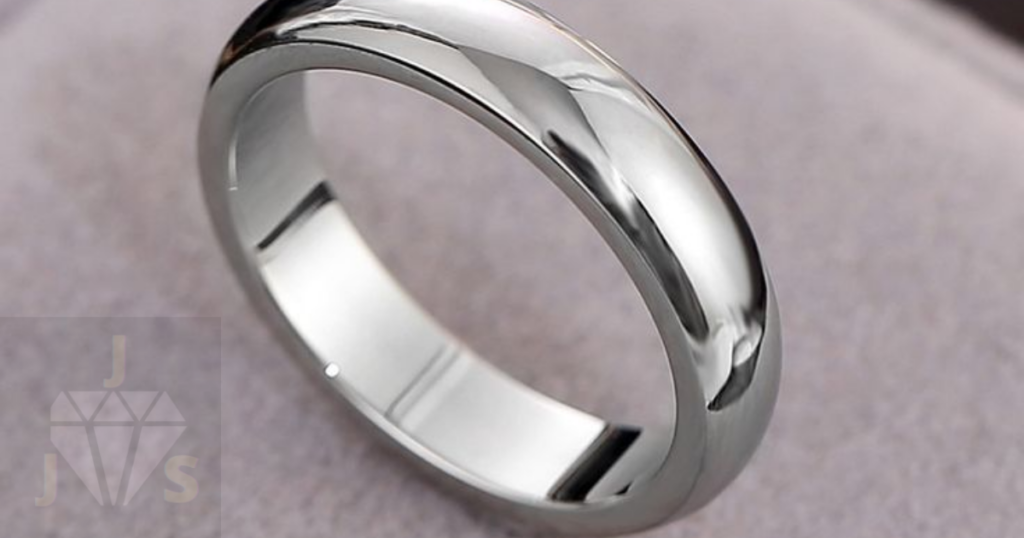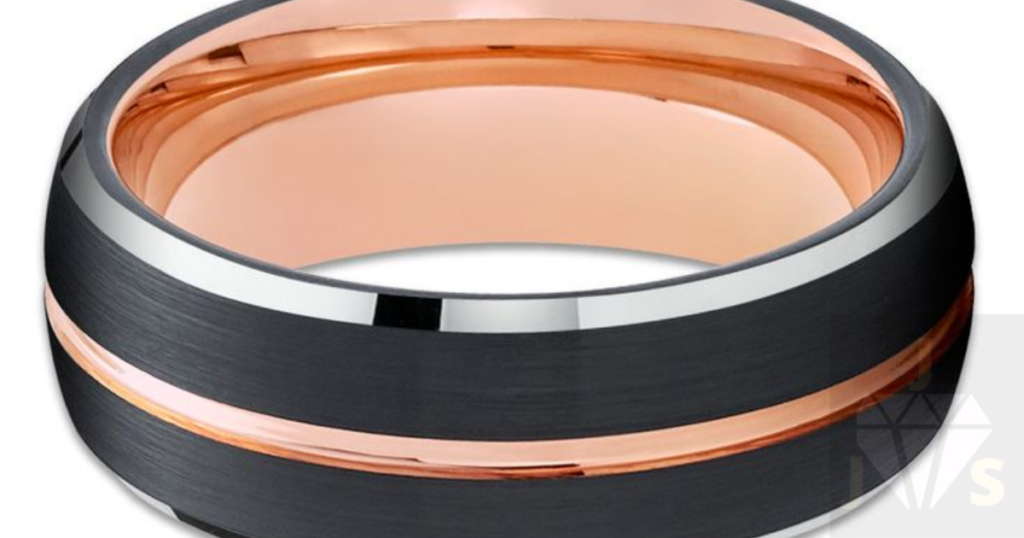When selecting the perfect metal for your jewelry, especially for pieces as significant as wedding bands or cherished accessories, two popular options often come to mind: tungsten vs silver jewelry.
Each offers unique advantages and potential drawbacks in terms of affordability and durability.
Understanding these differences can help you make an informed decision that suits your lifestyle and preferences.
Tungsten, particularly in its alloy form known as tungsten carbide, is renowned for its exceptional hardness and durability.
Ranking around 8.5 to 9 on the Mohs hardness scale, it is one of the hardest materials used in jewelry, surpassed only by diamonds.
This remarkable hardness makes tungsten highly resistant to scratches and everyday wear and tear, ensuring that jewelry pieces maintain their pristine appearance over time.
Tungsten’s natural gunmetal gray color offers a modern and industrial aesthetic that appeals to contemporary jewelry designs.

Silver has been a cherished metal in jewelry making for centuries, celebrated for its bright, reflective luster and timeless elegance.
However, silver is relatively soft, ranking around 2.5 to 3 on the Mohs hardness scale, making it more susceptible to scratches, dents, and deformation.
Silver is prone to tarnishing when exposed to air and moisture, requiring regular polishing and maintenance to preserve its shine.
Despite these considerations, silver’s malleability allows for intricate designs, making it a versatile choice for various jewelry pieces.
Tungsten jewelry has gained popularity for its unique combination of durability and affordability, making it a top choice for budget-conscious shoppers.
Compared to precious metals like gold and platinum, tungsten stands out as a cost-effective alternative without sacrificing style or longevity. High-quality tungsten rings are available at accessible price points, often ranging between $50 and $300 depending on the design and craftsmanship.
The affordability of tungsten doesn’t mean a compromise on quality. In fact, tungsten jewelry boasts incredible scratch resistance, which keeps it looking new for years.
However, the price of tungsten pieces can vary based on additional factors like craftsmanship, design complexity, and the inclusion of extra materials such as gold or diamond inlays.
These elements can elevate the cost but also add uniqueness to your jewelry.
For anyone searching for a durable and stylish option at a fraction of the price of traditional metals, tungsten remains a solid choice.
That said, ensure that the retailer provides authentic tungsten carbide to guarantee the long-lasting quality associated with this material.
Silver has been cherished for centuries, offering an elegant and timeless appeal that fits both contemporary and traditional designs.
While generally more affordable than precious metals like gold or platinum, silver jewelry prices can vary widely depending on its purity, design intricacy, and the global silver market’s fluctuations.
Sterling silver, which is 92.5% pure silver mixed with 7.5% alloy metals like copper, is the most common form used in jewelry.
It balances durability with affordability, making it suitable for everyday wear. Fine silver, which is 99.9% pure, offers a higher level of purity but is softer and less durable, often reserved for intricate or ornamental pieces.
Although silver may require regular maintenance to prevent tarnishing, many people consider it a worthwhile investment.
Its classic beauty and versatility ensure that silver jewelry never goes out of style, and it can easily complement various wardrobes and occasions.
For those who value both affordability and timeless charm, silver is an excellent choice.
One of tungsten’s most notable characteristics is its exceptional hardness, ranking 8.5 to 9 on the Mohs scale.
This makes it one of the most durable metals used in jewelry, highly resistant to scratches and capable of maintaining its sleek appearance even with daily wear.
For individuals with active lifestyles or those who work with their hands, tungsten is an ideal choice.

However, this remarkable hardness comes with a trade-off. Tungsten’s rigidity makes it brittle under extreme pressure or impact.
Unlike softer metals that bend or dent, tungsten can crack or shatter when subjected to significant force.
This property is something to consider if you lead a lifestyle where your jewelry may experience heavy impacts.
Another limitation of tungsten is its inability to be resized. Once crafted, tungsten rings cannot be adjusted due to the metal’s rigidity.
Therefore, ensuring an accurate fit at the time of purchase is crucial, particularly for engagement or wedding bands intended for lifelong wear.
Silver is significantly softer than tungsten, ranking only 2.5 to 3 on the Mohs scale. This softness makes silver more prone to scratches, dents, and bending, especially with everyday use.
However, silver’s malleability also allows for intricate designs, making it a favorite for custom and detailed jewelry pieces.
One of silver’s most common drawbacks is its susceptibility to tarnishing. Exposure to air, moisture, and certain chemicals can cause a dull or discolored surface over time.
Regular cleaning and polishing are essential to maintain silver’s bright, reflective luster.
Despite these challenges, silver offers a practical advantage: it can be resized. Whether it’s a silver ring or bracelet, resizing or repairs can typically be done with ease, accommodating changes in finger or wrist size over the years.
This flexibility makes silver a versatile option for those who want their jewelry to adapt to life’s changes.
When choosing between durable jewelry metals like tungsten vs. silver jewelry, understanding their advantages and limitations is essential.
Durability:
Tungsten is renowned for its impressive scratch resistance, making it perfect for jewelry pieces that endure daily wear.
Its strength ensures that tungsten jewelry retains its polished appearance for years, making it an ideal choice for affordable jewelry metals that deliver on longevity.
Hypoallergenic:
Tungsten is a great choice for those with sensitive skin or metal allergies. Provided the alloy is free from nickel, tungsten jewelry is generally hypoallergenic, reducing the risk of irritation or allergic reactions.
Modern Aesthetic:
With its natural gray tone and polished finish, tungsten has a sleek, industrial look that appeals to modern tastes.
Many tungsten rings feature inlays of wood, gold, or other materials, adding unique design elements to their contemporary charm.
Affordability:
Compared to gold and platinum, tungsten is far more cost-effective. It offers the look and durability of high-end metals at a fraction of the cost, making it an excellent option for those seeking stylish yet affordable jewelry metals.
Brittleness:
While tungsten is incredibly hard, this property also makes it brittle. Under extreme impact or pressure, tungsten can crack or shatter instead of bending.
This can be a drawback for those with active lifestyles involving potential accidents.
Non-Resizable:
Due to its rigidity, tungsten rings cannot be resized. It’s vital to ensure accurate sizing when purchasing tungsten jewelry, especially for wedding bands or rings.
Weight:
Tungsten is denser and heavier than many other metals, which can feel uncomfortable for some wearers. However, others appreciate the substantial feel of a tungsten piece as a mark of its quality.
Limited Color Options:
Tungsten naturally comes in a gray tone, though black, gold, or rose coatings are available. However, these coatings may wear off over time, exposing the original gray surface.
Timeless Beauty:
Silver is celebrated for its brilliant luster and elegant charm, making it a go-to metal for both classic and modern jewelry designs. Its timeless appeal ensures it never goes out of fashion.
Workability:
Silver’s softness allows jewelers to craft intricate, detailed designs, offering limitless style options. Whether it’s ornate bracelets or delicate necklaces, silver’s versatility is unmatched.
Affordability:
Silver is less expensive than metals like gold or platinum, making it accessible to a broader range of budgets.
It offers a great balance between affordability and aesthetic appeal, ideal for those seeking silver jewelry that doesn’t compromise on elegance.
Resizability:
Unlike tungsten, silver jewelry can be resized or repaired with ease. This flexibility is particularly useful for rings and other pieces that might need adjustments over time.
Tarnishing:
Silver is prone to tarnishing when exposed to air, moisture, and certain chemicals. Over time, this can dull its appearance, requiring regular cleaning and polishing to restore its shine.
Softness:
Ranking lower on the Mohs hardness scale, silver is softer than tungsten. It can scratch, dent, or bend more easily, especially if worn daily. While this may require extra care, many still choose silver for its classic beauty.
Allergenic Potential:
Some silver alloys, such as those containing nickel, may cause allergic reactions in sensitive individuals. Opting for sterling silver (92.5% silver) or nickel-free options can help mitigate this issue.
When deciding between tungsten vs. silver jewelry, your lifestyle, preferences, and budget play key roles. Tungsten offers unmatched durability and affordability, making it a fantastic choice for daily wear.
Meanwhile, silver’s timeless beauty and resizability make it ideal for those seeking versatile and elegant pieces.
Tungsten is an excellent choice if you prioritize durability and scratch resistance, particularly for items like wedding bands that endure daily wear. Its modern, industrial aesthetic appeals to those seeking a contemporary look.
However, ensure that you have the correct ring size, as tungsten rings cannot be resized. Consider your lifestyle; if you engage in activities that may subject the ring to significant impact, be mindful of tungsten’s brittleness.
Leave a comment